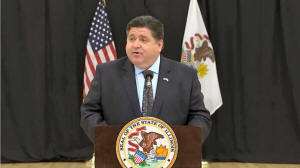One year into pandemic, Pritzker ‘cautiously optimistic’ about
large-scale events
 Send a link to a friend
Send a link to a friend
[March 12, 2021]
By TIM KIRSININKAS
Capitol News Illinois
tkirsininkas@capitolnewsillinois.com
 SPRINGFIELD – One year into the COVID-19
pandemic, Gov. JB Pritzker on Thursday announced a new initiative
focusing on vaccine access for rural parts of the state and said he is
“cautiously optimistic” about future reopenings and public gatherings. SPRINGFIELD – One year into the COVID-19
pandemic, Gov. JB Pritzker on Thursday announced a new initiative
focusing on vaccine access for rural parts of the state and said he is
“cautiously optimistic” about future reopenings and public gatherings.
Speaking in a news conference at a mass vaccination site at Shabbona
Middle School in Morris Thursday, Pritzker said he is encouraged that
the state is “getting to the end” of the COVID-19 pandemic, but he
continued to stress patience as the state works to vaccinate residents.

One week after announcing a vaccine equity initiative for urban areas
and communities of color, the state on Thursday announced that it would
also begin to direct federal deliveries of doses to nine downstate
critical access hospitals. The nine locations include hospitals in
downstate Christian, Ford, Hamilton, Logan, Mercer, Montgomery,
Tazewell, Vermillion and Wayne counties.
“Rural communities deserve the same protections from the virus that
suburban and urban communities get,” Pritzker said. “While national
demand is still higher than national supply, my team is allocating what
we receive from the federal government across the state as soon as we
get it.”
Public health officials announced that a total of 112,776 vaccine doses
were administered across the state on Wednesday, the second consecutive
day that over 100,000 doses were administered in a single day.
The state’s seven-day rolling average for doses administered stands at
98,116, the highest mark to date, while the seven-day rolling COVID-19
positivity rate stood at 2.2 percent, matching a pandemic low.
The Illinois Department of Public Health announced an additional 1,700
new confirmed and probable cases of COVID-19 on Thursday out of 89,893
total test results. IDPH announced 55 additional deaths due to COVID-19
Thursday, bringing the state’s death toll to 20,863.
A total of 1,118 individuals were reported to be hospitalized with
COVID-19 and of those, 231 were in intensive care units and 102 were on
ventilators – all were at their lowest point of the entire pandemic.
[to top of second column]
|

Gov. JB Pritzker speaks at a mass vaccination site at
Shabbona Middle School in Morris on Thursday (Credit: illinois.gov)

Earlier this week, the city of Chicago announced both Chicago
professional baseball teams will allow spectators at games with up
to 20 percent capacity, and there is optimism for the return of
summer events such as the Taste of Chicago and the Chicago Air and
Water Show.
The state currently remains in Phase 4 of the Restore Illinois
reopening plan, which prevents gatherings of more than 50 people.
Phase 5 is triggered when “either a vaccine is developed to prevent
additional spread of COVID-19, a treatment option is readily
available that ensures health care capacity is no longer a concern,
or there are no new cases over a sustained period.”
When asked about the possibility of loosening restrictions on
gatherings and potentially moving forward to the next phase of
reopening on Thursday, Pritzker said that he remains “cautiously
optimistic” that larger-scale events could begin to take place later
this year.
However, Pritzker noted that new variants of the virus that could be
transmitted more easily were of concern and could prevent a
widespread immediate reopening.
“I want to get to Phase 5 as fast as humanly possible,” Pritzker
said Thursday. “We're being cautious, but I'm also cautiously
optimistic. It's one of the reasons why we've begun to open up even
more.”

Pritzker expressed optimism that “medium-sized” gatherings could
take place late this summer, including conventions and outdoor
events, with safety precautions in place.
“We're going to keep moving as we can, based upon the guidance of
the scientists,” Pritzker added.
Capitol News Illinois is a nonprofit, nonpartisan
news service covering state government and distributed to more than
400 newspapers statewide. It is funded primarily by the Illinois
Press Foundation and the Robert R. McCormick Foundation. |